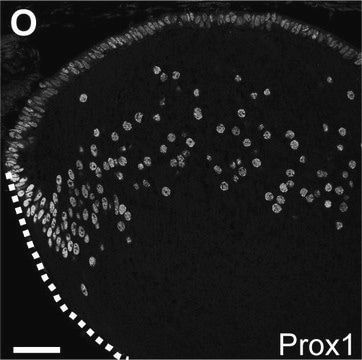Good at showing doublet bands for the AQP4 isoforms by Western blot, 1:1000 goes a long way. Fair bit of non-specific binding at higher molecular weights which originally messed with the chemiluminescence signal when I was optimising, but this became moot when I stated cutting the membrane to load beta-actin and AQP4 antibodies seperately (at the same time). Would not reccomend trying 1:2000 primary or using NFM to block/dilute, not sure how good it is on PVDF membranes but worked well on my nitorcellulose.
AB3594
Anti-Aquaporin-4 Antibody
CHEMICON®, rabbit polyclonal
Sinônimo(s):
Mercurial-Insensitive Water Channel
About This Item
Produtos recomendados
Nome do produto
Anti-Aquaporin 4 Antibody, CT, Chemicon®, from rabbit
fonte biológica
rabbit
Nível de qualidade
forma do anticorpo
affinity isolated antibody
tipo de produto de anticorpo
primary antibodies
clone
polyclonal
reatividade de espécies
mouse, human, rat
fabricante/nome comercial
Chemicon®
técnica(s)
immunohistochemistry: suitable
western blot: suitable
nº de adesão NCBI
nº de adesão UniProt
Condições de expedição
wet ice
modificação pós-traducional do alvo
unmodified
Informações sobre genes
human ... AQP4(361)
Descrição geral
Especificidade
Imunogênio
Aplicação
A previous lot of this antibody was used on rat brain sections.
Dilutions should be made using a carrier protein such as BSA (1-3%).
Western blotting:
1:500-1:1,000 using ECL on rat brain membranes.
Optimal working dilutions must be determined by the end user
Neuroscience
Ion & Transport Channels
Qualidade
Western Blot Analysis: 1:500 dilution of this lot detected AQUAPORIN 4 on 10 μg of Mouse Brain lysates.
Descrição-alvo
forma física
Armazenamento e estabilidade
Nota de análise
Clear vial of RbX Aquaporin 4, CT Control Antigen(AB3594-50ULb) included free of charge with the antibody is 120 µg of control antigen (lyophilized powder). Reconstitute with 100 µL of PBS. For positive control, in Western blot use 20 ng of protein per Minigel lane. For negative control, preincubate 3 µg of purified peptide with 1 µg of antibody for one hour at room temperature. Optimal concentrations must be determined by the end user.
Outras notas
Informações legais
Exoneração de responsabilidade
Não está encontrando o produto certo?
Experimente o nosso Ferramenta de seleção de produtos.
Classe de risco de água (WGK)
WGK 2
Ponto de fulgor (°F)
Not applicable
Ponto de fulgor (°C)
Not applicable
Certificados de análise (COA)
Busque Certificados de análise (COA) digitando o Número do Lote do produto. Os números de lote e remessa podem ser encontrados no rótulo de um produto após a palavra “Lot” ou “Batch”.
Já possui este produto?
Encontre a documentação dos produtos que você adquiriu recentemente na biblioteca de documentos.
Active Filters
Nossa equipe de cientistas tem experiência em todas as áreas de pesquisa, incluindo Life Sciences, ciência de materiais, síntese química, cromatografia, química analítica e muitas outras.
Entre em contato com a assistência técnica










